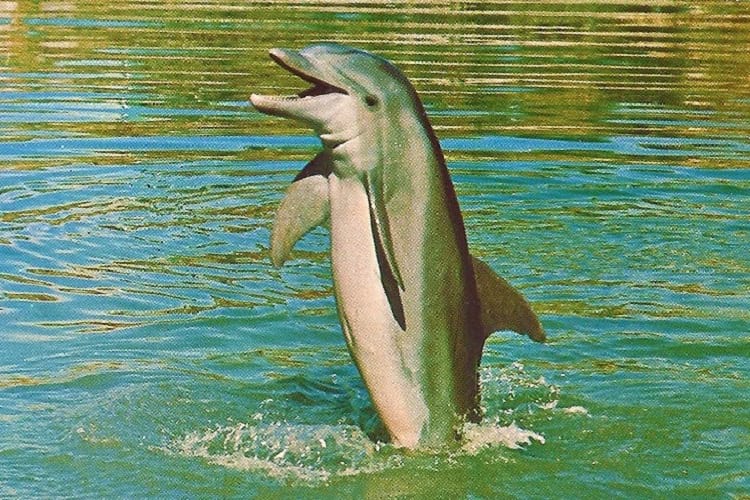Animal Suicide: Do Animals, Like Humans Resort to Ending their Own Lives?
Share

Animal Suicide: Kathy, one of the five bottlenose dolphins that were part of a famous television show called Flipper. The dolphin reportedly committed suicide after being depressed for a long time. (1950sUnlimited / Flickr)
Humans commit suicide, is a given. Do nonhuman animals commit suicide? Well, that’s not a given. Generally speaking, it’s a moot point. A human contemplates on past, present and future. He may seek closure in self-inflicted death. Animals, ostensibly, live in present with limited hindsight and foresight. So, why would they want to die? But, the ground realities reveal that suicide could be a way with non-humans as well.
Animal Suicide: Dogs and horses have done it
Man’s best friend, a dog, was in news in 1845, for committing suicide. The Illustrated London News reported that a dog of Newfoundland breed lay low for a couple of days, and then, threw itself in water, attempting to drown. It was rescued. But it rushed once again to deep waters and was rescued yet again. This exercise continued for long. In the long last, dog succeeded in drowning to death, something that he was dead bent to accomplish. Another case of a chain of canine suicides was highlighted by this portal under the head, ‘Overtoun Bridge from where dogs leap to their deaths’. Despite tangible holes in suicide theory, it is hard to ignore that animals too may choose to die, out of their own free will.
Consider man’s second-best friend, horse. Aristotle (384-322 BC), described one which jumped into a gorge and killed self. The horse had unwittingly mated with its biological mother. A case like Oedipus, the mythical king who unwittingly married his biological mother. When the couple realized the truth of their relationship, both were full of remorse. The lady killed self, and Oedipus renounced the world.
Grief/monotonous existence/choice of a less painful death, have triggered animal suicides
The list of suicide-prone animals is long and mindboggling. Dogs prostrating at the graves of their dead masters and dying. A cat, unable to bear the grief of her dead kittens, chooses to die. A herd of cattle, as recently as 2009, jumps off a cliff in Swiss Alps over a period of 3 days. A deer jumps to death over a slope, preferring to die by a bone-crushing fall rather than fall to hunting dogs.
The suicide of a dolphin, star of the 1960 television show, Flipper, made waves. It is believed that the dolphin grew tired of monotonous life and decided to die. Dolphins are an intelligent creature. They have the ability to observe their thought processes and choose one that suits them best at a particular point in time. They are also unique in being voluntary breathers, unlike humans and other animals who are involuntary breathers. Dolphins breath consciously whereas for other life forms breathing is automatic, uncontrolled, reflex action. That means the dolphin may decide not to breathe till it dies from lack of oxygen. Since such observations can’t be reproduced in experimental conditions, it remains a tentative finding. Nevertheless, this self-induced death of a dolphin is a strong argument in favour of animal suicides.
Suicide bombers do exist in the animal kingdom
Further, there are some life forms which act as suicide bombers. The objective though, is not self-centred, as in suicide, but is self-denial for a larger good. For example, the exploding ants of Malaysia. These ants blow their head or abdomen (autothysis) in the face of a threat. The blow scatters a paste which traps and kills the threat. Thus, a suicide/self-sacrifice saves fellow ants from an enemy. A similar defence is characteristic of a termite (Globitermes sulphurous). It catches hold of the intruder/enemy and pumps its (termite’s) abdomen to release glue which spills over both the lives pitted against each other. The glue hardens upon coming in contact with air, killing them both. Likewise, pea aphid blows up its body to scare, even kill a predator, to save its commune. In what’s closest to committing suicide, it may surrender to a natural parasite, the wasp, to lay eggs on its body. Young wasps feed on aphid body, killing it in the process of growing up. A volunteer aphid thus barters its life to buy protection for the rest of the aphid group from wasp attack. Much like the grandma story of a village and a demon. To contain demon to lesser harm, one villager would volunteer to walk to the demon’s cave every day, and offer himself as food to the demon. That would keep the demon in good humour and save the rest of the village from demon’s wrath.
Self-sacrifice could be suicide by default
Consider self-sacrificing crab spider. It feeds her young ones with her unfertilized eggs. The taste of eggs hooks young ones to the taste of their mother’s body. And the mother is devoured, bit by bit, till it goes lifeless. Matriphagy, the act of feeding on mother’s body, is also observed in some species of scorpions, insects and amphibians. This may be a case of maternal care gone awry but does prove that there is a thin line that separates life and death. If self-preservation was a baseline of animal behaviour, as generally believed, such cases of self-denial wouldn’t be seen among animals. Can these instances, be construed to mean suicides?
Man, unlike animals, may philosophise to choose death
Is suicide a consequence of physical factors? If yes, there are parallels between humans and non-humans. Like, the monotony of existence, perceived pain and tragedy, a drug or substance-induced fatal attraction, etc. Risk of suicide goes up significantly in a man living on anti-depressant drugs. That’s a physical factor prompting suicide. But it is well known that metaphysical factors are significant drivers of human suicide. An IAS officer Mukesh Pandey makes a detailed video of him explaining why he is about to commit suicide. The officer isn’t bogged down by any pain or tragedy, but feels, vaguely, that life isn’t worth living. Does such a metaphysical angle apply to animals as well? Can animals contemplate that life isn’t worth living? Well, as of now, we have no way of knowing.
The mystery of dog-suicides in Scotland remains unsolved
For dog suicides at Overtoun Bridge in Scotland, one explanation is that dog being colour-blind, can’t separate bridge from surrounding greenery, and trips in the intervening space. Another view is that the smell of rodents living in the downside of the bridge lured the canine for a fatal jump. No cause-effect relationship has been established till date and dogs leaping to death from bridge remain a mystery. In stressful situations, scorpions sting their own selves and die. Sceptics say that a fearful scorpion goes sting-stabbing recklessly, and swirling at the same time. And, in an error of judgement, stings its own body and dies. A case of self-defence gone haywire. Were the dogs jumping off the Overtoun bridge doing so in some kind of self-defence?
Can one life use another for its own survival?
Could there be something that programmed the canines, in the above example, to go for daredevil jumps? Can a parasite programme the host animal to go daredevil? There is one interesting case. The infection of a protozoan, Toxoplasma gondii, in the brain of rat. It programs rat to go daredevil and for a purpose. The protozoan parasite needs the body of a cat to complete its life cycle. Because it can reproduce sexually only in a cat’s biosystem. So, what does it do to reach to a cat which a normal rat will always avoid? The parasite hijacks the rat’s neuro-mechanism which helps it remain away from the cat. The infected rat, so to say, is reprogrammed to be attracted to a cat. That obviously makes it easy prey for its natural predator, and the parasite thus gains access to the cat’s body. Could there be more such cases of one life driving another to the path of self-destruction?
Overall, suicide in animals remains an enigma
What is crystal clear is this that sentience is part of animal psychology, like it is of a human being. Both are aware of life, pain and crisis situations. Both may choose death over life in a particular set of circumstances. But suicide is not the same thing as dying for one’s community or fellow beings. It ought to be a closure for a suffering or an unacceptable status of life. Such closure is clear in human suicides as it is communicated by the subject before dying or inferable from cogent circumstantial evidences. No such so closure can be inferred in animal suicides as animal-human communication is extremely limited. Moreover, the metaphysical side of suicide makes it a subject beyond the reach of scientific investigation. Therefore, it is hard to prove, as well as to disprove, that animals commit suicide. Doubtless, there are radical differences in the thought process of humans and non-humans. Suicide, seemingly, is not one of those differences. Or, maybe, we should wait till a standard definition of suicide is drafted.
Enjoyed this article? Also, check out “Overtoun Bridge: A Mysterious Site from Where Dogs Leap to Their Deaths“.
Fact Analysis:
STSTW Media strives to deliver accurate information through careful research. However, things can go wrong. If you find the above article inaccurate or biased, please let us know at [email protected]













